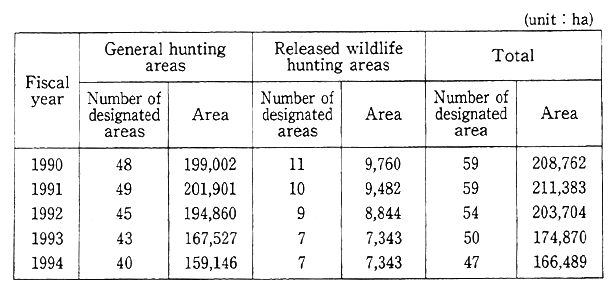Quality of the Environment in Japan 1995
(2) In Tokyo's wards, Osaka City, Nagoya City and other urban areas, where there had been significant degrees of ground subsidence, this phenomenon appears to have slowed or virtually stopped as a result of controls on withdrawal of groundwater and other measures. In other areas, there are signs of long-term improvement, but ground subsidence remains a problem in some areas such as Minami-Uonuma.
(3) As a result of many years of ground subsidence, buildings, faci-qities structures, irrigation facilities, port facilities, harbor facilities, farmland and agricultural facilities have been damaged in many dis-tricts, and in some areas that are at or below sea level, there is a danger of severe disasters such as floods, high tides and tidal waves (Tsunami).
Fig. 9-2-2 Ground Subsidence Conditions in Japan
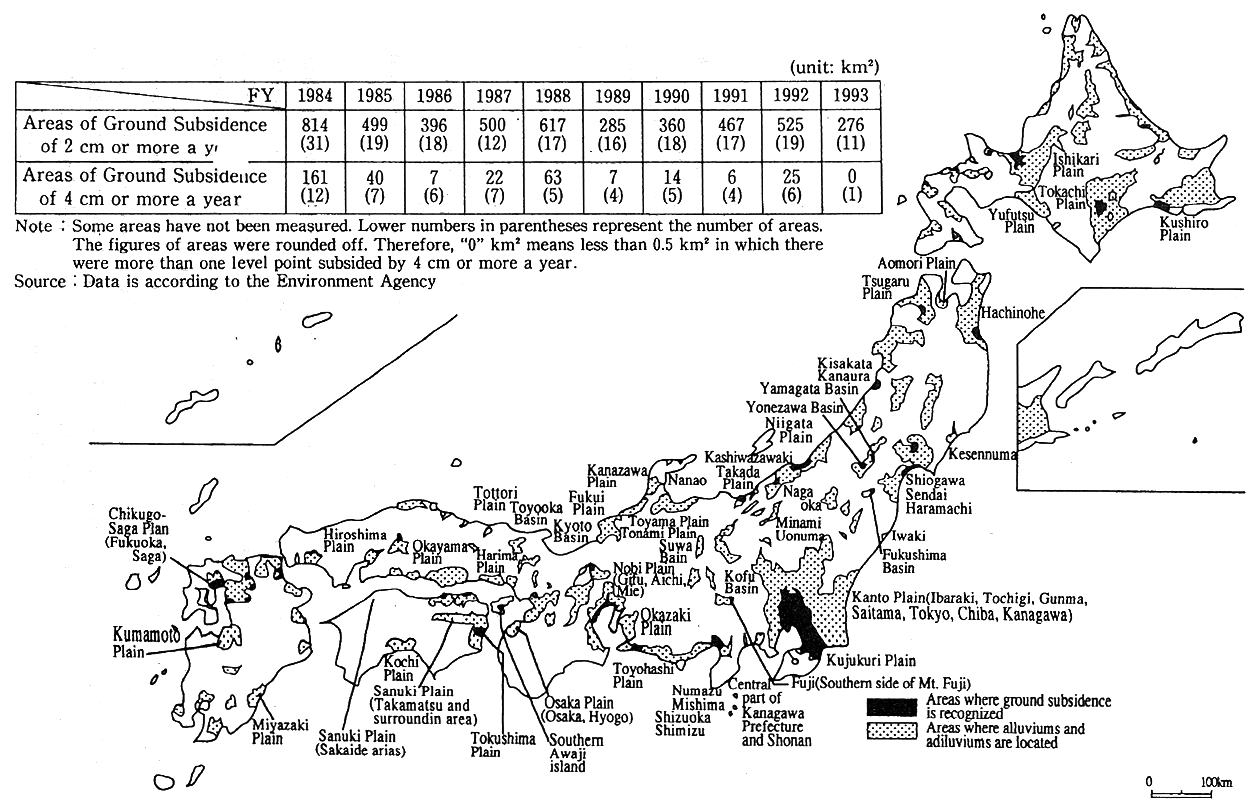
2. Preservation Measures for Ground Environment
In order to prevent ground subsidence, withdrawal of ground-water had been controlled under the Industrial Water Law and the Law Concerning the Regulation of Pumping-up of Underground Water for Use in Buildings (the Building Water Law). At present some districts of 10 prefectures and of 4 prefectures have been designated under these laws respectively. Also in many districts, efforts of reducing volume of groundwater withdrawal are being made, such as local governments controls on groundwater withdrawal, voluntary restraints on use of groundwater for industrial purposes and administrative guidance for reducing volume of groundwater withdrawal, etc.
A broad range of surveys were also carried out in fiscal 1994 as part of countermeasures for ground subsidence. These included provid-, ing assistance to local governments in survey of ground height fluctua-tion of groundwater level, and in geological survey for monitoring and measurements in restricted areas ; leveling to determine the extent of ground subsidence; surveys to measure volume of groundwater with-drawal ; surveys to examine the measures for ground subsidence on the Nobi Plain and Chikugo-Saga Plain; surveys to investigate land environ-ment preservation policies accompanying use of underground; surveys to equip for land environment information around Tokyo area; surveys to investigate countermeasures for ground subsidence during periods of drought surveys and research on the appropriate level of groundwater withdrawal; surveys on the appropriate level of usage of ground water to provide guidance for voluntary restraints in use of groundwater for industrial purpose; surveys and guidance to enhance the efficiency of industrial water use ; surveys to manage and preserve ground water through monitoring groundwater level and water quality ; survey to investigate countermeasure of ground subsidence such as restoration of agricultural facilities and irrigation system ; and related activities.
In order to reduce the volume of groundwaterwithdrawal, pro-jects were also carried out to develop surface water resources and provide substitute water. In those areas where measures were specially needed for industrial water, projects for industrial water supplies as measure of ground subsidence were carried out.
In areas where significant ground subsidence has already occur-red, projects were carried out to repair the resulting damage as well as projects to construct protection facilities from floods and high tides, projects to construct facilities for removing inner drainage, projects to construct seacoasts protection facilities, and projects for land improve-ment.
As mentioned above, numerous activities are in progress to deal with ground subsidence, but to assure that further subsidence does not occur, a comprehensive policy is needed. To attain this objective, outline of measures for preventing ground subsidence were formulated in April 1985 for the Nobi Plain and for the Chikugo-Saga Plain, and in Novem-ber 1991 for the northern Kanto Plain. In these outlines, various counter-measures, such as securing supply of substitute water, are promoted. Also concerning the outlines of measures for preventing ground subsi-dence for the Nobi Plain and for the Chikugo-Saga Plain, since the goal of reducing the volume of groundwater withdrawal have been reached in 1994. the reexamine of the outlines have been carrying out.
Section3. Status of Soil Pollution and Countermeasures
1. Status of Soil Pollution
The Detailed Agricultural Land Surveys for the Prevention of Soil Pollution (Detailed Survey) have been conducted since 1971 focusing on areas where pollution is suspected. These surveys are done based on the Agricultural Land Soil Pollution Prevention Law that requires up-to-date information of soil pollution by specified harmful substances. In 1993, surveys on cadmium were conducted at 15 sites in eight prefec-tures covering 794 hectares, and a survey on copper was conducted on one site in one prefecture covering one hectare (no survey has been conducted on arsenic). The survey result indicated that there was no area where specific harmful substances had been found to become a newly designated area for preventive measures (areas where values were in excess of the standard values). The aggregate total of areas where values were in excess of the standard values was 128, covering an aggregate area of 7,140 hectares.
In terms of soil pollution in cities, the polluted area has not been very noticeable because of the fact that they are usually privately owned and scattered. However, more and more polluted sites have been reported due to the concerns of the public over environmental pollution by newly developed chemicals that came with the recent expansion of industrial activities and higher standards of living. The increase is also due to the public concern over soil pollution caused by illegal dumping of wastes. Monitoring of groundwater quality are also contribute to the increase in finding of polluted areas.
2. Countermeasures for Soil Pollution
(1) Setting environmental quality standards
The environmental quality standards for soil were formulated in accordance with Article 16 of the Basic Environment Law as the standards to protect human health and conserve the living environment. Those standards are expected to be used for judgement over whether the soil is polluted and over which improvement measures associated with soil pollution should be taken.
The environmental quality standards for soil are now set for a total of 25 items ; ten items including cadmium set in March 1991, and 15 items of organochlorine compounds, etc set in June 1994.
(2) Measures to prevent soil pollution on agricultural land
As of November 30, 1994, within all areas where concentrations in excess of environmental quality standards were detected, 6,250 hectares (65 sites) had been designated for countermeasures and plans for such countermeasures were mapped out for 6,140 hectares (64 sites) of the above. Through the special enterprises established to improve soil quality for the purpose of preventing public hazards (funded by the national fund), works of corrective actions such as soil removal, soil dressing and changes of water sources have been completed for 4,520 hectares. This will bring the improved area to a total of 4,920 hectares including works done by individual prefectures, and 68.9% of the correc-tive works for areas with detection of values exceeding the standard value has been completed (Table 9-3-1).
In cadmium-polluted areas, incidentally, measures are taken to prevent the production of contaminated rice as a provisional measure which will remain in force until the projects are completed.
In addition, basic soil environment surveys have been conducted at set points to obtain knowledge on agricultural land pollution by heavy metals.
Also, in areas where agricultural land is polluted, the effective-ness of soil transfer and soil improvement are studied in the form of on-site experiment for soil improvement.
Because of the recent trend to use recycled organic materials produced during sewage treatment, prevention of soil pollution has been emphasized according to the management standards relating to the prevention of heavy metals accumulation in the agricultural land soil.
Table 9-3-1 Progression of Farmland Soil Pollution Countermeasures
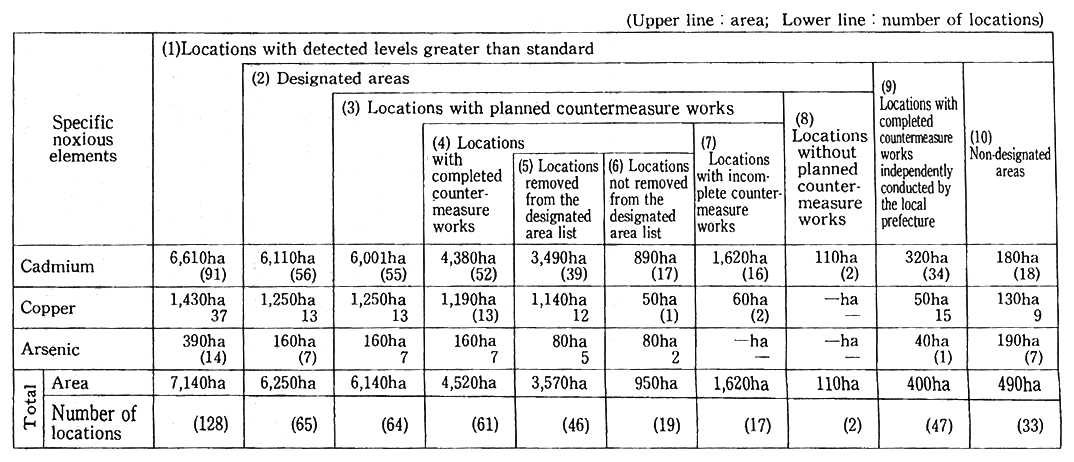
Notes : 1. "Areas with detected levels greater than standard" are according to detailed studies conducted through Fiscal Year 1993.
2. The total area and number of locations may not equal the sum of the columns since one location may contain more than one noxious element.
3. The sum of the rows does not equal the number of "locations with detected levels greater than standard" or the totals because some designated areas have, for the purpose of countermeasures, been subdivided and some designated areas have been partially removed from the designated area list. The numbers in parentheses indicate the number of duplicates.
4. "Locations with completed countermeasure works" and "Locations with completed countermeasure works independently conducted by the local prefecture" include areas that have been put to other uses.
5. "Locations with completed countermeasure works" are locations that have undergone completed countermeasure works with assistance from the national government (including areas with the completion of countermeasures scheduled prior to the end of Fiscal Year 1994).
(3) Urbanized area soil pollution prevention measures
As regards the soil of urbanized areas, surveys are conducted on compliance with environmental quality standards by taking advantage of opportunities for land transformation when there are clear or pos-sible signs of soil pollution. It is made a practice to encourage entrepre-neurs to take measures necessary for the prompt achievement of envi-ronmental quality standards when it is clear that the soil is actually polluted. As the result, the "Guidelines for Surveys and Countermea-sures against Soil Pollution Caused by Heavy Metals, etc." and the "Tentative Guidelines for Surveys and Countermeasures against Soil and Groundwater Pollution by Organochlorine Compounds, etc." were provided to the local governments in October 1994. These guidelines are compendiums of methods and procedures on how to accurately survey and provide countermeasures against soil and groundwater pollution. The Japan Environment Corporation is providing loans to business proprietors so that they can cover the cost of implementing the counter-measures against polluted urban soils.
Surveys are conducted to develop new purification techniques for the soil polluted by materials such as heavy metals and trichloroeth-ylene. Also a survey was conducted to collect information on how to analyze the substances for which the quality standards for the soil environment had not yet been set.
(4) Mine pollution prevention measures
In the area of metal mining, preventive measures have been implemented to prevent mine pollution, according to the Mine Safety Law. There is always a danger of mine pollution in the mining facilities even after the closings of operation. Because of this, efforts were made to implement planned activities designed to prevent mine pollution, and to develop a secure and permanent treatment of water from the aban-doned mines based on the "Special Measures for Mine Pollution Caused by Metal Mining Industries." In 1993, this law's basic policy concerning preventive projects for mine pollution was amended (implemented on 1 April 1993). This amendment attempts to implement planned prevention projects for mine pollution and includes the following measures
1) Promotion of preventive works to prevent mine pollution at closed or inactive mines funded by the Supplementary Funding Set Aside for Works to Prevent Mine Pollution at Closed or Inactive Mining Sites
In 1993, mine pollution prevention works for 32 mines and waste water treatment works for 24 mines with absent owners, and other waste water treatment works for 47 mines with owners present, were supported through this funding mechanism.
2) The Metal and Mining Industries Corporation engaged in loan and loan guarantee activities for the business proprietors who are responsible for the expenses of soil improvement works and mine pollution prevention works needed for designated facilities that are no longer in use. Other activities engaged in by this corporation were the management and operation of special reserve funds for the prevention of mine pollution and the fund for mine pollution prevention works, research studies for development of the prevention technologies for mine pollution, and guidance to local governments on research and design for mine pollution prevention works.
Section4. Present Status of Pollution by Agricultural Chemicals and Countermeasures
1. Present Status of Pollution by Agricultural Chemicals
Along with an increased use of agricultural chemicals after the Second World War, the pollution of food and the environment with BHC, DDT, dieldrin, organic mercury agents, etc., became a serious social problem. However, such highly toxic or persistent agricultural chemicals are now neither used nor registered for sale in Japan, owing to the strengthening of regulations regarding their use under the revised Agricultural Chemicals Regulation Law (hereinafter referred to as "the Law") and to the appearance of less toxic chemicals developed by the advancement of science and technology, etc., since 1971. Therefore, the environmental pollution caused by such persistent agricultural chemi-cals has nowadays decreased.
The agricultural chemical usage on golf courses and resulting water pollution also became the social problem. However, the situation has been improving gradually as the result of steady implementation of the "Provisional Guidelines for Prevention of Water Pollution by Agricultural Chemicals Used at Golf Links" established in 1990, and also the result of the promotion of various countermeasures implemented according to a report entitled "Measures to Preserve the Quality of Water Sources for Public Use" developed by the Central Environment Council in December 1993.
However, as agricultural chemicals potentially give bioactivity to living organisms in the environment, it is necessary to properly assess their safety and control them in order that they do not cause adverse effects to human health and the environment.
2. Countermeasures against Pollution by Agricultural Chemicals
Now in Japan, in order to prevent pollution by agricultural chemicals, all agricultural chemicals are registered for sale through inspection of persistence, toxicity, etc., under the Law. Any agricultural chemical must satisfy all of the following standards for registration (1) persistence in agricultural products; (2) persistence in soil; (3) toxicity against aquatic animals and plants; and (4) water pollution. As of 1 January 1995, standards on persistence in agricultural products have been established for 212 agricultural chemicals and standards on water pollution for 41 agricultural chemicals. (Further, common quality stan-dards for persistence in soil, etc. is used for all of the chemicals.)
Even after its registration, any agricultural chemical may be appointed, by Cabinet Order based on the Law, as an agricultural chemical of crop persistence, of soil persistence or of water pollution and its use may be strictly regulated in cases that it is liable to cause damage to men and livestock through crops, soil or water. Table 9-4-1 shows the chemicals with use restrictions under each category.
From the standpoint of preserving the water quality in public water areas the Environment Agency established "Evaluation Guide-lines for Water Quality on Agricultural Chemicals in Public Water Areas" for agricultural chemicals which are used widely such as those for aerial application. The Direction for Safe Use of Agricultural Chemicals was also established for the prevention of water pollution. Measures to strengthen the cooperation among the related administra-tive agencies within the local government were also taken for this purpose. In addition, simazine, which is widely used as a herbicide on golf courses, was newly classified as agricultural chemical of water pollution and its use has been restricted for the purpose of protecting human health only to designated areas.
Table 9-4-1 Agricultural Chemicals Regulated to Prevent Environmental Pollution
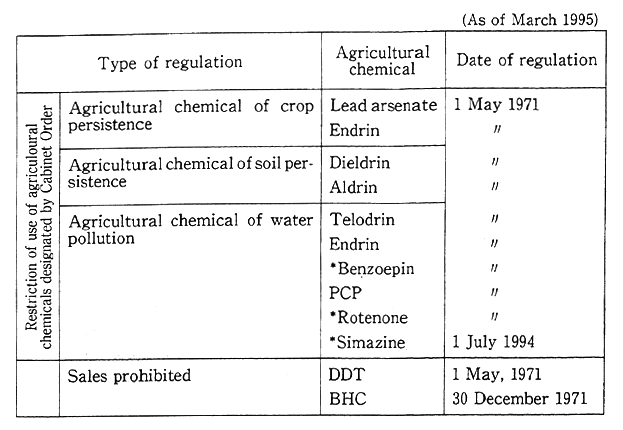
Note : The (*) mark indicates an agricultural chemical that is currently registered.
Chapter10. Promotion of Environmental Health Measures
Section1. Compensation and Prevention of Pollution-Related Health Damages
1. Brief Description of Compensation and Prevention System for Pollution-Related Health Damages
The Pollution-Related Health Damage Compensation Law estab-lished in 1974 to provide swift and fair protection to the patients of pollution-related health damage, played a major role in protecting the patients.
This system provides compensation to the patients of health hazards at the expense of the producers of pollutants through civil litigation. There are two categories of diseases covered by this law. One is illnesses which have no unique causal relationships with materials causing the illness (in Class I Areas where heavy air pollution is causing wide spread illness like asthma), and the other, in which there is a unique relationship with the material causing the illness such as Minamata Disease, Itai-Itai Disease and chronic arsenic poisoning (in Class Il Areas where environmental pollution is severe and frequent occurrence of the unique disease is observed).
In regard to the Class I Area, the recommendation on "How Class I Area under the Pollution-Related Health Damage Compensation Law Should Be Addressed" was issued by the Central Council for Environ-mental Pollution Control in response to the changes in the nature of the air pollution in October 1986. Based on this recommendation, the follow-ing amendments were made and have been implemented since March 1988:1) de classification of Class I Areas; 2) continuation of compensa-tion to the certified patients; 3) implementation of countermeasures to prevent health damages caused by air pollution; and 4) renaming of the law to the Law Concerning Compensation and Prevention of Pollution-Related Health Damage (referred to as "Compensation Law" here-inafter).
There exists no reason to revise the present compensation system since there has been no change in the scientific assessment that air pollution is not the major cause of asthma under the present condition of air pollution. Therefore, protections for the patients, and steady promotion of the present policy, which attempt to prevent health dam-ages, will continue unchanged.
In March 1995, the Law partially amending the Compensation Law was enacted, amended the system as follows:1) modification to requirements for payment of survivors' compensation ; and 2) establish-ment of special measures for renewal of authorization in the event of a disaster or other similar occurrence.
2. Illness Caused by Air Pollution
(1) Compensation for the existing certified patients
As of December 1994, there were 78,682 certified patients. There is no new certification due to the elimination of the Class I Area cate-gory in March 1988 (Table 10-1-1). The patients will continue to be re-certified, and receive compensations based on the Compensation Law. These compensations include:1) medical care benefits and medi-cal care expenses ; 2) compensation for handicaps ; 3) compensation for survivors; 4) lump compensation payment for survivors; 5) child com-pensation allowance; 6) medical care allowance ; 7) funeral expenses. The health care projects were also implemented to enhance the welfare of the certified. These projects include:1) rehabilitation; 2) medical care at a relocated area ; 3) supplying medical equipment for patient care at home; and 4) guidance on patient care at home.
The funding for the compensation comes from smoke-producing stationary facilities and automobiles. The sharing ratio of the compen-sation expenses is eight to two respectively.
The Pollution-Related Health Damage Compensation Grievance Board is established to assess the grievances regarding the certification and compensation determination. There were 197 requests for assess-ment as of December 1994. Of those, there were 18 retractions, 14 dismissals, 124 denials and 33 withdrawals.
(2) Implementation of health damage prevention projects
Following the enforcement of the amended Compensation Law in March 1988, the projects for the prevention of air pollation-related health damage were set force (referred to as "Health Damage Preven-tion Pojects" hereinafter). These projects attempt to supplement and improve the air pollution-related health damages prevention measures that already had been carried out by the national and local governments. Activities directly operated by the Pollution-Related Health Damage Compensation and Prevention Association (referred to as "Association" hereinafter) under this law are; 1) survey and research, 2) dissemination of knowledge and 3) training. Activities designed for the former Class I Areas, supported by the Association but operated by local governments or Japan Environment Corporation are; 1) plan development, 2) health consultation, 3) medical examination, 4) functional training, 5) facility improvement and 6) support for facility improvement (Figure 10-1-1).
Table 10-1-1 Designated Areas, Number of Certified Patients, and Other Matters under the Compensation Law
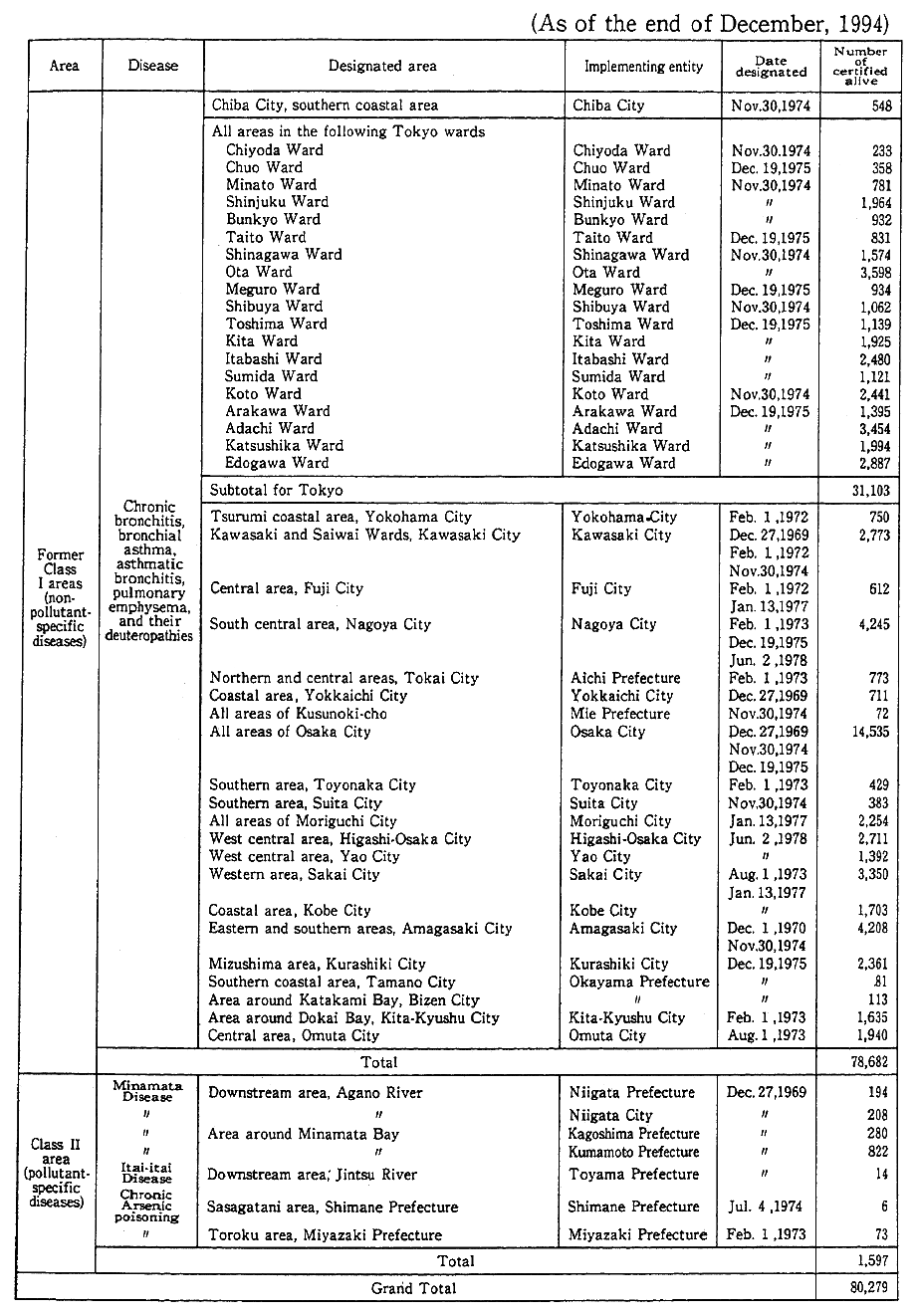
Note The indications of designated areas are all according to the demarcations in force at the time of designation.
Funding for this project comes from the profit earned by the investment of the endowment of the Association. Total capital is set for approximately 50 billion yen and the Association finances its annual operation by national financing and payments by the business proprie-tors who are directly responsible for air pollution or those with related business activities. The financing of this fund has been completed within 1994.
Prevention activities for health damages in 1994 are as follows:
1) Activities directly operated by the Association
The research on incidents of asthma in a large city and the research study for the improvement of air environment was undertaken under the category of research activity. The knowledge dissemination efforts included the swimming festival for asthmatic children, the low-pollution auto mobile fair, the air pollution prevention month campaign, and production of a pamphlet for asthma prevention and recovery. Training seminars were conducted for the personnel in charge of health damage prevention activities.
2) Subsidy by the Association
Grants were provided to 57 local governments and Japan Environ-ment Corporation. These grants were used for plan development for the improvement of air environment, health consultations concerning asthma, infants health assessment, functional training such as camps for children suffered from asthma, introduction of low-pollution automo-bile, tree planting for air purification and improvement of green tracts of land for air pollution prevention.
Fig. 10-1-1 Outline of Health Damage Prevention Projects
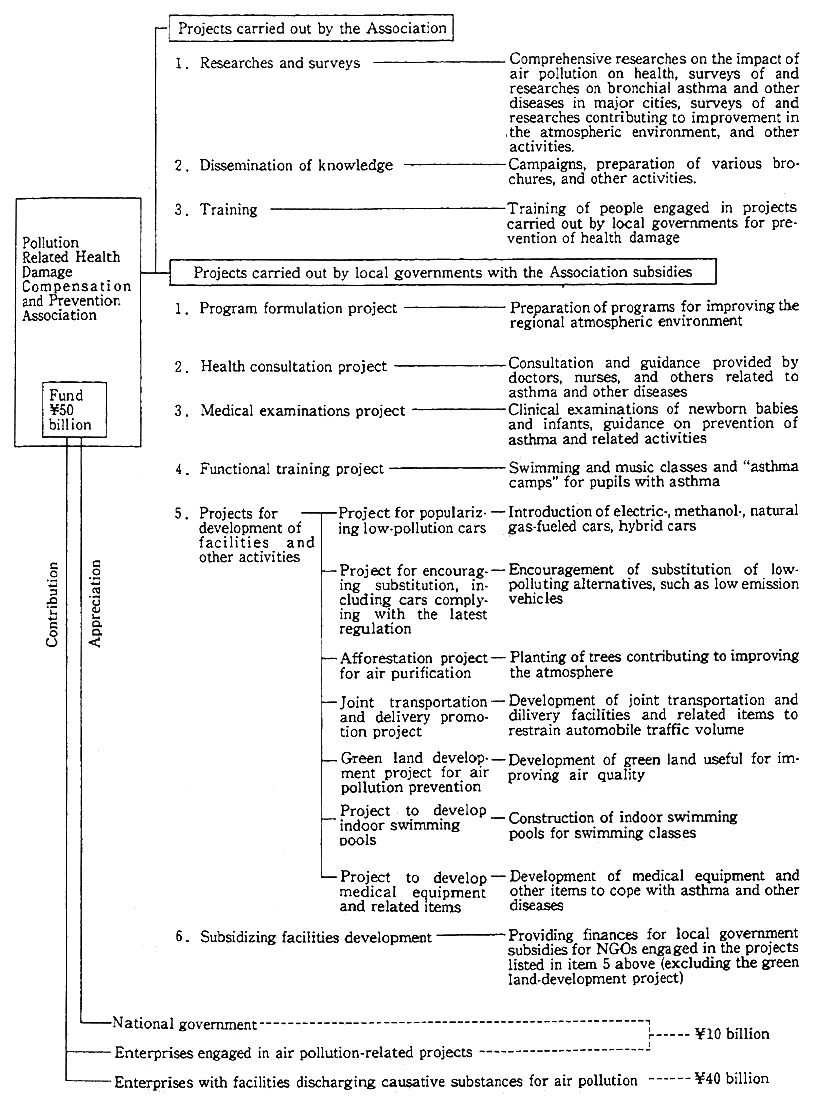
3. Minamata Disease
(1) Brief history
Minamata Disease was first discovered in May 1956, around Minamata Bay in Kumamoto Prefecture, and in May 1965, along the Agano River in Niigata Prefecture. In September 1968, the government announced its official opinion that Minamata Disease was caused by the consumption of fish or shellfish, contaminated by methylmercury com-pound discharged from the chemical plant of Chisso Co., Ltd. in Minamata City and Showa Denko Co., Ltd., located upstream of the Agano River respectively.
When the damages were discovered, the governments of Kumamoto and Niigata Prefectures each had separate measures coping with Minamata Disease. In December 1969, the Law Concerning the Relief of Pollution-Related Health Damage (hereafter referred to as the "Relief Law" ) was enacted naming all relevant sites as designated areas.
The decision delivered in September 1971, on the initial lawsuit for Niigata Minamata Disease, and the decision delivered in March 1973, on the initial lawsuit for Kumamoto Minamata Disease, each placed the responsibility of damage compensation on Showa Denko Co., Ltd. and Chisso Co., Ltd. On the basis of those results, the patients' group negotiated with the companies directly and the compensation agreement between the patients' group and Showa Denko Co., Ltd. was reached in June 1973, and the agreement between the group and Chisso Co., Ltd. in July of the same year. Since then all the patients have been receiving their compensation money directly from the responsible com-panies.
In September 1974, under the Compensation Law that succeeded the Relief Law activities of area designation and certification were taken over.
In Kumamoto there had been a sudden increase of certification requests for the Minamata Disease. To cope with these increased requests, "Agreements on the Promotion of Minamata Disease Counter-measures" was issued by the Inter-Ministry Committee for the Minamata Disease in June 1977. In response to this agreement, the "Criteria for Differentiation of Acquired Minamata Disease" was issued by the Director of the Environmental Health Department of the Envi-ronment Agency, clarifying and quantifying the medical certification procedures for the Minamata Disease. In Kumamoto, the operation was upgraded to perform 150 assessments and 120 judgments per month in October 1977 (250 assessments and 200 judgments per month in August 1986). Further, the Law Concerning Provisional Measures for Promotion of Administrative Work on Certification of Minamata Disease was established in February 1979, enabling the national government to directly administer the certification activities.
(2) Present status
1) Minamata Disease certification activities
As of December 1994, a total of 2,947 individuals had been certi-fied as Minamata Disease patients (1,770 in Kumamoto, 487 in Kago-shima, 690 in Niigata). Of those, 1,504 individuals are still alive (822 in Kumamoto, 280 in Kagoshima, 402 in Niigata).
The certification of Minamata Disease patients has been progres-sing smoothly in resent years. However, there still are a fair number of individuals requesting certification and some are refusing to be asses-sed. Further, there are some cases where verification of Minamata Disease is difficult because of the patient's advanced age, and some who could not be assessed because they are bed-ridden or even had passed away before the assessment could take place. Thus, at present, there still are a substantial number of individuals requesting certification (1,386 individuals-l,244 in Kumamoto, 138 in Kagoshima, four in Niigata).
To accelerate the certification process, the governments of Kumamoto and Kagoshima Prefectures make efforts to properly oper-ate and expand this assessment and eligibility determination system. Because of the increased need for assessing individuals living away from the home prefectures, assessment systems have been established in the Osaka, Nagoya and Tokyo area.
Certification of Minamata Disease is based on medical evidence. In October 1985, the certification criteria for Minamata Disease was reconfirmed at a meeting of medical specialists. Also in November 1991, the report on "Appropriate Measures to Cope with Minamata Disease," submitted by the Central Council for Environmental Pollution Control, included no mention of a necessity of amending the certification criteria.
2) Studies for treatment
Since 1974, subsidies began for treatment costs for the individuals whose certifications are delayed. Treatment studies also began in the same year to monitor the changing course of the illness.
3) Program of the Comprehensive Measures on Minamata Disease
In those areas where there had been an outbreak of Minamata Disease, because there is the possibility that many people have been exposed to various levels of methylmercury, there are still anxieties about the long-term effect of methylmercury on the health of the residents. The Environment Agency requested the Central Council for Environmental Pollution Control to advise on comprehensive measures to cope with these problems. In November 1991, the council submitted the advisory report on "Future Measures to Cope with Minamata Disease."
Since June 1992, based on this report, health management activ-ities were implemented to provide health examination to the residents who have high probability of methylmercury exposure. The program of the Comprehensive Measures of Minamata Disease were also im-plemented. These are medical care projects providing and subsidizing treatment and its cost for those with sensory impediments in their extremities but not certified as Minamata Disease patients. As of December 1994, a total of 4,078 individuals (3,030 in Kumamoto, 800 in Kagoshima, 248 in Niigata) were benefiting from these medical care activities.
4) Request for administrative grievance hearings regarding the denial of the Minamata Disease certification
Under the Relief Law, 630 individuals had submitted the request for the administrative grievance hearing to the Director-General of the Environment Agency by the end of December 1994. Rulings on these requests were 12 retractions, two dismissals and 410 denials. Thirty-six requests were withdrawn from the process. Under the Compensation Law, 675 requests had been submitted to the Pollution-Related Health Damage Grievance Board by the end of December 1994. Rulings for these requests were six retractions, two dismissals and 241 denials. Sixty-five requests had been withdrawn.
5) Lawsuits relating to the Minamata Disease
There are eight pending cases around the nation relating to the Minamata Disease naming the national and local governments as defen-dants. These suits were brought up by groups of individuals requesting the Minamata Disease certification concerning outbreak and expanding of the Minamata Disease and issues of the relief for the victims.
Since September 1990, six courts issued settlement recommenda-tions on damage compensation suits concerning the Minamata Disease around the Minamata Bay area. The national government responded that accepting the recommendation was difficult since the issues are so fundamental to the administration and can not be compromised through negotiation.
So far, the following rulings were delivered on the damage compensation suits where the national government, the government of Kumamoto Prefecture and companies causing pollution were named defendants.
(1) 30 March 1987 (Kumamoto District Court: defendants National Government, Kumamoto Prefecture, Chisso Co., Ltd.)
The court ruled that plaintiffs were victims of the Minamata Disease and found all defendants responsible for the compensation for damages.
(2) 7 February 1992 (Tokyo District Court: defendants National Government, Kumamoto Prefecture, Chisso Co., Ltd.)
The court ruled that plaintiffs could not be medically diagnosed as Minamata Disease victims. The court found Chisso Co., Ltd. respon-sible for compensation for damages but not the national government or the Kumamoto Prefecture.
(3) 31 March 1992 (Niigata District Court: defendants National Government, Showa Denko Co., Ltd.)
The court ruled that plaintiffs' sensory disorders could be traced to the Minamata Disease. The court found Showa Denko Co., Ltd. responsible for compensation for the damages, but not the national government.
(4) 25 March 1993 (Kumamoto District Court: defendants National Government, Kumamoto Prefecture, Chisso Co., Ltd.)
The court ruled that plaintiffs' health disorders were affected by organomercury compounds and found all defendants responsible for the compensation for damage.
(5) 11 November 1993 (Kyoto District Court : defendants National Government. Kumamoto Prefecture. Chisso Co.. Ltd.) The court ruled that the plaintiffs were victims of Minamata Disease and found all defendants responsible for the compensation for damage.
(6) 11 July 1994 (Osaka District Court:defendants National Govern-ment. Kumamoto Prefecture. Chisso Co.. Ltd.)
The court ruled that the plaintiffs' physical symptoms can be caused by the Minamata Disease. The court found Chisso Co.. Ltd. responsible for the compensation for damage, but not the national government or Kumamoto Prefecture.
All the cases above are appealed to higher courts.
6) Financial support measures for Chisso Co.. Ltd.
Chisso Co., Ltd., which caused the damages, makes direct com-pensation payments to the certified patients. To assist the company, the Cabinet agreed on "Countermeasures against the Minamata Disease" on 20 June 1978. This agreement called for the establishment of a special loan mechanism on behalf of Chisso Co., Ltd. relevant financial agencies. This agreement made a way for Kumamoto Prefecture to issue a special bond for the purpose of providing the loan to the com-pany. The purpose of this agreement is to prevent the possible interrup-tion of the compensation payments without compromising the responsi-bility of the company which caused the damage. These measures also had the purpose of stabilizing the financial as well as social climate of the affected area.
However, because of the rapid decline of Chisso Co., Ltd., pay-ment interruption became a possibility under the recent fast changing economic climate. To prevent this, the following measures were estab-lished at the Cabinet Meeting for the Minamata Disease on 9 September 1994, after consultations among ministries and agencies concerned : 1) lessening th,e company's share of responsibility for the already certified patients as an interim measure ; 2) local and national finanicial adminis-tr;ative arrangement f,or establishing the Minamata-Ashikita Area development fund by Kumamoto Prefecture, and the guarantee of the loans to the Chisso, facility development fund that is portioned out of the bond issued by Kumamoto Prefecture. These measures received proce-dural approval in the Cabinet Meeting on 13 September 1994.
7) The National Institute for Minamata Disease
The National Institute for Minamata Disease was established in Minamata City, Kumamoto Prefecture in 1978 to conduct comprehen-sive research into Minamata Disease. It consists of the Basic Research Department, the Epidemiological Research Department and the Admin-istrative Section 6, is engaging in research activities for the development of treatment methodologies and other related activities for Minamata Disease.
The Institute was designated as a cooperating institution of WHO in 1986. The Institute held the "International Workshop on Mercury Pollution" in 1992, and sent professionals to Brazil for the study of mercury pollution in the Amazon River. The Institute held the "Sympo-sium on Environmental Pollution and the Health Effects of organo-mercury Compounds" with the joint auspices of WHO in October 1993, and the "International Symposium on Mercury Effects in the Amazon River" in 1994 under the Japan-Brazil Agreement on Science and Technology in Rio de Janeiro. It also participated in the Mercury Analysis Technology Transfer Project by JICA.
4. Itai-Itai Disease
(1) Brief history
Itai-Itai Disease was first reported as a unique disease without any known cause in an academic conference in October 1955. In May 1968, the Ministry of Health and Welfare announced that chronic cadmium poisoning first caused kidney disorder and then osteomalacia, and defined this disease as Itai-Itai ("Ouch-Ouch") Disease. It also announced that pregnancy, nursing a baby, disorders in hormone bal-ance, aging and inadequate calcium intake were additional factors that caused this disease. The Ministry also addressed the opinion that cadmium causing this chronic poisoning could only be found in the waste water of Kamioka Mine operated by Mitsui Mining and Smelting Co., Ltd. In December 1969, the Jintsu River area was assigned as a designated area under the Relief Law and as a Class II Area in 1974 under the Compensation Law that was the successor of the Relief Law.
(2) Present status
As of December 1994, there were 14 patients alive (of a total of 156 patients under the Relief Law or Compensation Law). In addition, the Toyama prefectural government conducts health check-up pro-grams for nine individuals who should be under observation.
As of December 1994, there were seven patients requesting hear-ings from the Pollution-Related Health Damage Compensation Griev-ance Board based on the Compensation Law. Four received retraction and three received denial rulings.
5. Chronic Arsenic Poisoning
(1) Brief history
In July 1972, the first patient of Chronic Arsenic Poisoning was identified in the study of Toroku district in Miyazaki by the Miyazaki prefectural government. The district became a designated area in February 1973 under the Relief Law.
The first case of Chronic Arsenic Poisoning in Sasagatani district was identified in August 1973 in the study by the Shimane prefectural government. The area became a designated area under the Relief Law in July 1974.
Both areas were designated as Class II Areas in September 1974 under the Compensation Law that succeeded the Relief Law.
(2) Present status
As of December 1994, there were 73 patients in Toroku district (of a total of 145 patients under the Relief Law or Compensation Law). There also were six patients in Sasagatani district (total 21 patients under the Relief Law or Compensation Law).
As of December 1994, there were 67 individuals requesting the hearing from the Pollution-Related Health Damage Compensation Grievance Board based on the Compensation Law. Seven received retraction and 48 received denial rulings. Twelve cases were withdrawn.
Section2. Research on Environmental Health Science
1. Basic Research on Environmental Health Policy
The Environment Agency has been conducting studies to estab-lish a Surveillance System on Environmental Health and issued an interim summary report in 1992. The system aims at by continuously observing the relationship between the state of the health of demo-graphic human groups in the community and the state of the air pollution on a regular basis, detecting changes at early stage and taking prompt and appropriate measures in necessity.
The agency also has been conducting studies to develop methodol-ogies to evaluate the health effect of localized pollution such as the one found along the roads with heavy traffic. An interim report on this subject was published in 1992.
Also conducted were a study on the relationship between hay fever and substances in polluted air since 1991, a study on the health effects of ultraviolet radiation since 1993, and study on the health effects of electromagnetic waves.
The Pollution-Related Health Damage Prevention and Compen-sation Association also conducted studies on prevention for air pollution related health damages.
2. Studies on Cadmium Effects on Health
An ongoing health survey on citizens living in the cadmium-polluted area has been conducted to assess the cadmium effects as pointed out in the opinion issued by the Ministry of Health and Welfare in 1968. The purpose of the survey is to prevent cadmium-related health damages. This survey has found no patient of Itai-Itai Disease except in the Jintsu River area in Toyama Prefecture. The Environment Agency has been monitoring the health status of individuals whose health was found to be affected by the pollution in the study conducted from 1979 through 1984.
At present, a clear causal relationship between cadmium pollu-tion and irregularity of the proximal convoluted tubule has not been established. Neither the cause of Itai-Itai Disease nor cadmium effects on human body have been well understood. To answer these questions, the Environment Agency has been conducting studies and produced the interim reports in 1989 on ; 1) animal experiments (aged monkeys) to study the effect of long-term administration of small amount of cad-mium; 2) studies on symptoms of low molecular weight albminuria observed in residents of cadmium-polluted areas :3) studies on preven-tion and aftercare of the Itai-Itai Disease patients ; and 4) pathological investigation of certified patients or individuals needing observation through biopsy and autopsy.
The above reports recommended the continuation of studies on the effects of cadmium exposure on kidney and bones. As such, these studies are still under way to investigate the effect of cadmium on. the health of humans.
The Environment Agency has been conducting a comprehensive study on Minamata Disease and a comprehensive study on the effect of heavy metal on human body. These studies are to promote scientific investigations on the effects of water contamination on the human body.
Chapter11. Settlement of Pollution Disputes and Control of Environmental Crime
Section1. Settlement of Pollution Disputes and Pollution Complaints
1. Present Status of Pollution Dispute Settlement
The Environmental Dispute Coordination Commission, an exter-nal body of the Prime Minister's Office, and the Prefectural Environ-mental Dispute Settlement Committee established by each prefecture are responsible for settlement of pollution disputes under the Law for the Settlement of Environmental Pollution Disputes (Figure 11-1-1).
There are four types of settlement: mediation, arbitration, inter-cession and judgement. Judgement has two types, responsibility and cause. The responsibility judgement concerns the determination of responsibility and amount of damage compensation money to be award-ed. The cause ruling concerns the causal relation between the damages from pollution and alleged polluting activities.
The Environmental Dispute Coordination Commission exclusive-ly handles judgement. This commission also handles mediations, arbitra-tion and intercessions for so-called serious cases (Minamata Disease and Itai-Itai Disease for example), and cases involving airplanes and Shin-kansen trains. The Prefectural Environmental Dispute Settlement Committees handle other mediations, arbitration and intercessions for all other types of cases.
(1) Cases handled by the Environmental Dispute Coordination Commission
There were 11 new pollution dispute cases submitted to the Environmental Dispute Coordination Commission in fiscal year 1994. Adding to the 11 pending cases of the previous year, there was a total of 22 pollution dispute cases (one mediation, 14 arbitrations and seven responsibility judgements) in fiscal year 1994. They are as follows:
1) Cases for mediations
Cases in which mediation was requested to prevent noise from the Hokuriku Shinkansen Trains...1 case
Fig. 11-1-1 Pollution Disputes Settlement System
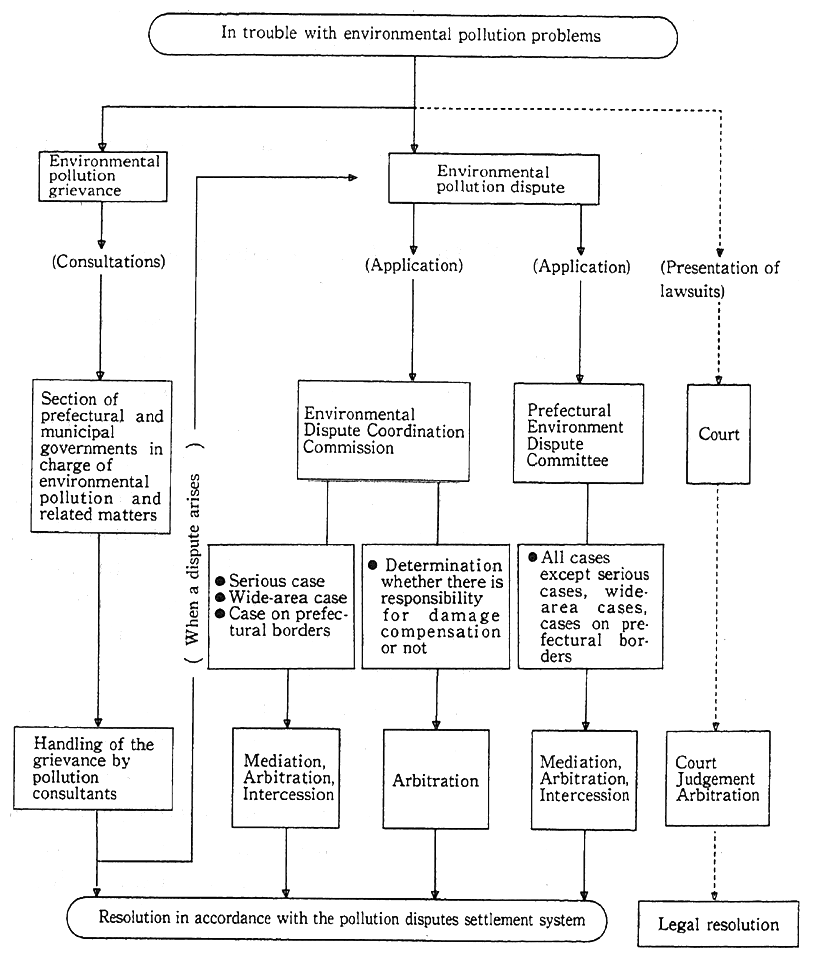
2) Case for arbitrations
i. Cases in which arbitration was requested for the compensation of damages from Minamata Disease along the coast of the Sea of Shiranui...1 case
ii. Cases in which arbitration was requested to prevent noise from the Hokuriku Shinkansen Trains...2 cases
iii. Cases in which arbitration was requested to prevent noise and vibration from the Tokaido Shinkansen Trains...2 cases
iv. Cases in which arbitration was requested regarding damages from water pollution caused by liquid detergents...2 cases
v. Cases in which arbitration was requested regarding damages from water pollution caused by industrial waste of Toyoshima Industry Co., Ltd...2 cases
vi. Cases in which arbitration was requested regarding damages from water pollution caused by CNP...1 case
vii. Cases in which arbitration was requested regarding damages from noise caused by the high pressure gas distribution center...1 case
viii. Cases in which arbitration was requested regarding damages from noise and vibration caused by the metal manufacturing factory...2 cases
ix. Cases in which arbitration was requested regarding damages from water pollution caused by Niigata CNP...1 case
3) Cases for responsibility judgement
Cases in which the judgement was to be made on responsibility for noise along the Odakyu Railway..4 cases
Of those requests, one mediation and seven arbitration requests, totaling eight cases, were settled in 1994. They are as follows the case for mediation of preventing noise from the Hokuriku Shinkansen trains, the case for arbitration of the compensation of damages from Minamata Disease along the coast of the Sea of Shiranui, the cases for arbitration of preventing noise from the Hokuriku Shinkansen trains, the cases for arbitration regarding damages from noise and vibration of the Tokaido Shinkansen trains, the case for arbitration regarding damages from water pollution caused by CNP, and the case for arbitra-tion regarding damages from water pollution caused by CNP in Niigata
The remaining 14 cases were carried over to fiscal year 1995.
(2) Cases handled by the Prefectural Environmental Dispute Settlement Committee
There were 38 new environmental pollution dispute cases submit-ted to the committees in fiscal 1994. Adding 78 pending cases from the previous year, the Prefectural Environmental Dispute Settlement Com-mittees handled a total of 116 cases nationwide in fiscal 1994. All of them were arbitration cases.
Forty-nine of them were settled in fiscal 1994.
Described below is an example of an actual case settled by the committee.
[Case Example] On 2 March 1994, the petitioner complained that the noise of the air conditioners installed at the retailer of game machines next door was so loud that it was interfering with his sleep and causing sensory and psychological damages such as irritation. The petitioner requested the business proprietor (the petitioned) to take corrective actions to reduce the noise of the air conditioners.
The Niigata Prefectural Environmental Dispute Settlement Com-mittee arrived at the following settlement on 5 August 1994, after a site investigation and five committee meetings;
1) To extend the existing noise reduction wall by about four meters by 6 September 1994.
2) To change to the low noise setting for two of four air condi-tioners.
3) Not to operate four air conditioners from 8: 00 p.m. to 8: 00 a. m.
4) To install an automatic timer by 6 September 1994, so that air conditioners operate as directed in item 3).
5) To pay breach-of-contract damages to the petitioner in case of non-compliance with either the wall extension works specified in item 1), or installment of the timer specified in item 4).
6) To pay breach-of-contract damages to the petitioner in case the air conditioners are in operation outside of the time span described in the item 3).
2. Settlement of Environmental Pollution Complaints
(1) System for settlement of environmental pollution complaints
Complaints about pollution must be taken seriously since they are problems close to the lives of the area residents. Proper settlement of such complaints is also important for preserving the living environment of the residents and for the prevention of future pollution.
From this perspective, the local governments, jointly with the relevant administrative organizations, are to provide proper settlement of the pollution complaints according to the Law for the Settlement of Environmental Pollution Disputes. For this purpose, prefectures and municipalities are competent in having consultants for pollution com-plaints.
The Environmental Dispute Coordination Commission provides the information and guidance to assist local governments in dealing appropriately with pollution complaints.
(2) Present status of environmental pollution complaints
Nationally, the Prefectural Environmental Dispute Settlement Committees received 79,317 complaints in fiscal 1993, an increase of 3,131 complaints or 4.1% from the previous fiscal year.
Looking at the trend, the number of complaints peaked at 87,764 in fiscal 1972 and declined from fiscal 1973 through fiscal 1982. How-ever, the number has begun to increase again since fiscal 1983.
The seven kinds of typical environmental pollution include air pollution, water pollution, soil pollution, noise, vibration, ground subsi-dence and offensive odor. The other kinds of pollution include illegal dumping of wastes, sunshine interference and interference of radio waves. In 1979, the number of complaints against the seven kinds of typical environmental pollution dipped below the level of 50,000 that had persisted for the previous ten years. In 1993, the number of complaints was 43,175, a decrease of 1,801 or 4.0% compared with the previous fiscal year. The percentage of the seven kinds of typical environmental pollution out of all complaints has gone down to 54.4%.
The number of complaints against the other kinds of pollution has been increasing since 1977. In 1993, there were 36,142 complaints, an increase of 4,932 or 15.8% compared with the number of the previous fiscal year. The percentage of the other kinds of pollution complaints was 45.6%. (Figure 11-1-2)
(3) Status of complaint resolution
In 1992, 74.7% of complaints were resolved (settlement complet-ed) within one month of the time the complaint was made. Of the petitioners 26.7% are "satisfied" and 45.3% are "generally satisfied." Combined, 72.0% of petitioners were satisfied with the settlement they received. (Figures 11-1-3 and 11-1-4).
Fig. 11-1-2 Trends in Number of Grievances
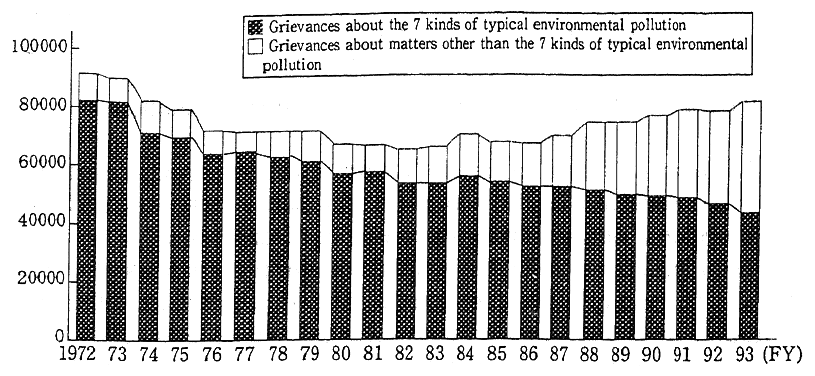
Note: Data according to the "Report of Survey on Number of Griev-anaes about Environmental Pollution in FY 1993" by Environ-mental Dispute Coordination Commission.
Figs 11-1-3 Time Required for Settlement of Environmental Pollution Grievances

Fig. 11-1-4 Degree of Satisfaction with Grievance Settlements

Note: Data according to the "State of Environmental Pollution Dispute in Public Bodies in FY 1992" by Environmental Dis-pute Coordination Commission.
3. State of Settlement by the Police of Complaints about Environmental Pollution
In fiscal 1994, police accepted 75,765 pollution complaints (exclud-ing traffic pollution), an increase of 4,022 compared with the number of fiscal 1993.
Classification of these complaints received are shown in Table 11-1-1. Complaints about noise occupy 88.8% of all complaints.
Table 11-1-2 show the status of the police handling of these complaints. Majority of the complaints were resolved by warning and guidance.
Table 11-1-1 Types of Environmental Pollution Grievances Accepted by the Police (1994)

Note Data according to the National Police Agency.
Table 11-1-2 Handling of Environmental Pollution Grievances Accepted by the Police (1994)

Note Data according to the National Police Agency.
Section2. Control of Environmental Pollution Offenders
1. Main Focus of Offender Control and Status of Arrests
The police mainly focus on the malicious illegal dumping of industrial wastes and water pollution. Total arrests of environmental pollution offenders were 2,365 in fiscal 1994 and Table 11-2-1 shows the status of arrests in the past five years.
When classified according to the laws under which arrests were made, a majority or 98.3% of violations occurred under the Waste Disposal and Public Cleansing Law (hereafter referred to as "Waste Disposal Law").
Table 11-2-1 Number of Arrests for Environmental Pollution Offenses (1990-1994)
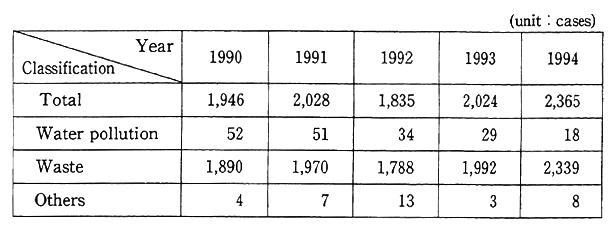
Note Data according to the National Police Agency
Table 11-2-2 Number of Arrests for Environmental Pollution Offenses by Law (1994)

Note Data according to the National Police Agency.
2. Control of Water Pollution Offenders
The police made 18 arrests for offenses against the Water Pollution Control Law in fiscal 1994. Of those, 11 were the result of violating the effluent standards defined under the Water Pollution Control Law by factories.
3. Control of Waste Disposal Offenders
The status of the 2,324 arrests in fiscal 1994 is shown in table 11-2-3. They were violations of the Waste Disposal Law. There were many cases of illegal waste dumping, taking up 72.9% of the total crimes.
Table 11.2-3 Arrests by Type of Waste Disposal Violation (1994)

Note Data according to the National Police Agency.
The total amount of illegally disposed industrial waste relating to the industrial waste offenses was estimated at 1.11 million tons. Figure 11-2-1 shows the distribution of the illegally disposed wastes according to the kinds and locations. Still significant is the illegal dumping or unlicensed treatment of urban industrial wastes dumped in remote mountains beyond the prefectural boundary.
Fig. 11-2-1 Illegal Dumping of Industrial Wastes

Note Data according to the National Police Agency
4. Cases Handled by the Public Prosecutor's Office for the Violations of Laws Related to Environmental Pollution
Table 11-2-4 shows the national trend in the number of individuals handled by the public prosecutor's office in the past five years. They were the individuals who were arrested and arraigned by the public prosecutor's office for their violations of laws relating to environmental pollution. There were 3,298 violators in fiscal 1994, an increase of 61 compared with in the previous fiscal year.
Table 11-2-4 Trends in Number of Persons Reported and Disposed for Violations of Laws Related to Environmental Pollution
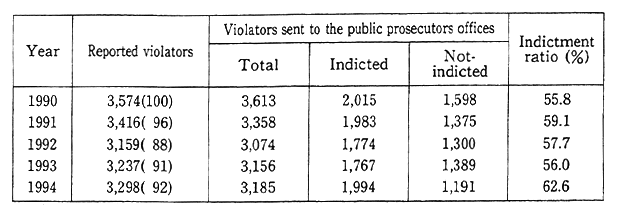
Notes:1. Data according to the Ministry of Justice.
2. Figures in parentheses are an index based in 1990.
3. Indictment ratio (number of persons indicted/(number of persons indict-ed + number of persons not-indicted)) × 100.
Table 11-2-5 shows the number of regular violators categorized by crime names. As shown in this table, the highest is the violation of the Waste Disposal Law, counting 2,323 individuals sharing 70.4% of the total arrests. This was followed by the violations of the Law relating to the Prevention of Marine Pollution and Maritime Disaster, and those of the Water Pollution Control Law. Compared with the previous fiscal year, violations of the Waste Disposal Law have increased by 287, and those of the Law relating to the Prevention of Marine Pollution and Maritime Disaster have decreased by 1.96.
Table 11-2-6 shows the number of persons processed in violations of laws related to environmental pollution. This table is categorized according to the name of crimes. The number of persons prosecuted amounted to 1,994 or 62.6%, while 1,191 were not prosecuted. Of those prosecuted, 88 were required to stand trials, an increase of 26 compared with the previous fiscal year. Summary trials were recommended for 1,906 individuals, an increase of 201, and these occupied 95.6% of the total prosecuted.
Table 11-2-5 Number of Persons Reported for Violations of Laws Related to Environmental Pollution
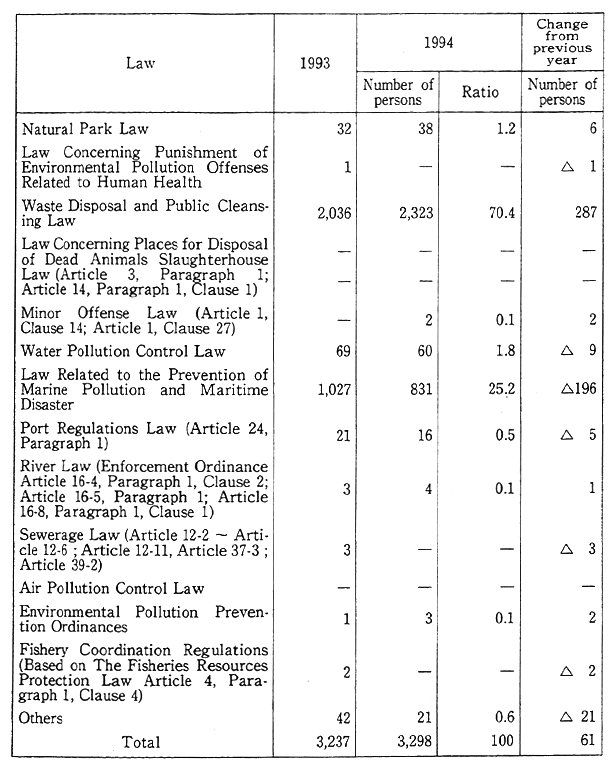
Notes; 1. Data according to the Ministry of Justice.
2. The mark ![]() indicates a decrease.
indicates a decrease.
Table 11-2-6 Number of Persons Sent to the Public Prosecutor's Offices for violatins of Laws Related to Environmental Pollution
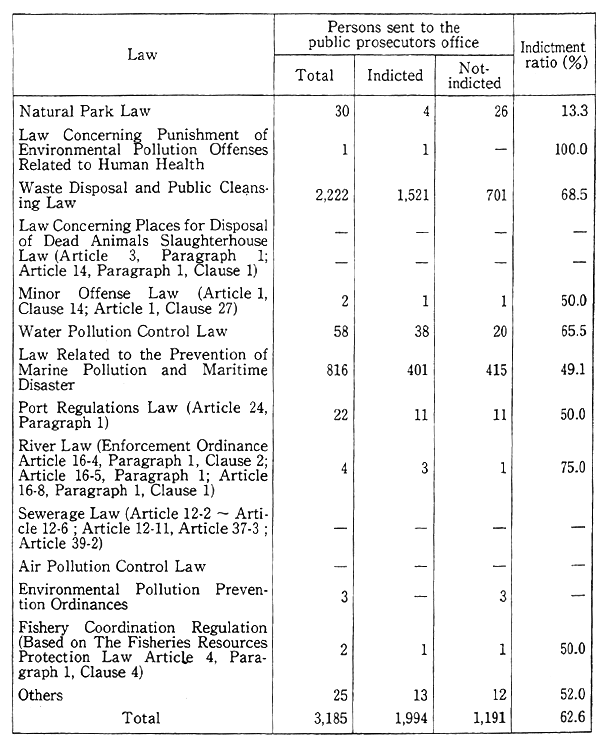
Notes 1. Data according to the Ministry of Justice.
2. Indictment ratio = (number of persons indicted/(number of persons indict-ed + number of persons not-indicted)) × 100
Chapter12. Conservation of the Natural Environment
Section1. Comprehensive Effort to Conserve the Natural Environment
1. Implementation of the National Survey on the Natural Environment
For appropriate conservation of the changing natural environ-ment as well as the wildlife living there, it is necessary to accurately grasp the current condition and damages of the natural environment, which consists of the vegetation which covers our land, rivers, lakes and marshes, and the coastline, etc.
To collect such basic information, the National Survey on Natural Environment, based on the Nature Conservation Law, has been conducted. The survey is generally called the Green Census. It has been conducted 4 times, usually in five year periods, since 1973.
In fiscal year 1994, as a part of the 5th National Survey on the Natural Environment, the Vegetation Survey and the Seashore Survey were started. Further, to grasp the biological diversity in Japan, the Biological Diversity Survey which consisted of the Species Diversity Survey and the Ecosystem Diversity Survey was newly launched (Figure 12-1-1).
An information system for biological diversity was investigated, which collects data such as specimen information, and preservation and supply information.
2. Increasing Awareness of Nature Conservation and Promoting Environmental Education
With the recent increase in leisure time and progressing urbaniza-tion, the public's desire for opportunities to be in contact with nature has increased. To secure places where people can be in contact with nature and to provide people with the opportunity to use these places it is important to promote the appropriate use of the natural environment.
For this reason, the Environment Agency, striving to create even better measures, in fiscal year 1994 promoted the following:
Fig. 12-1-1 Overview of the National Survey on the Natural Environ-ment
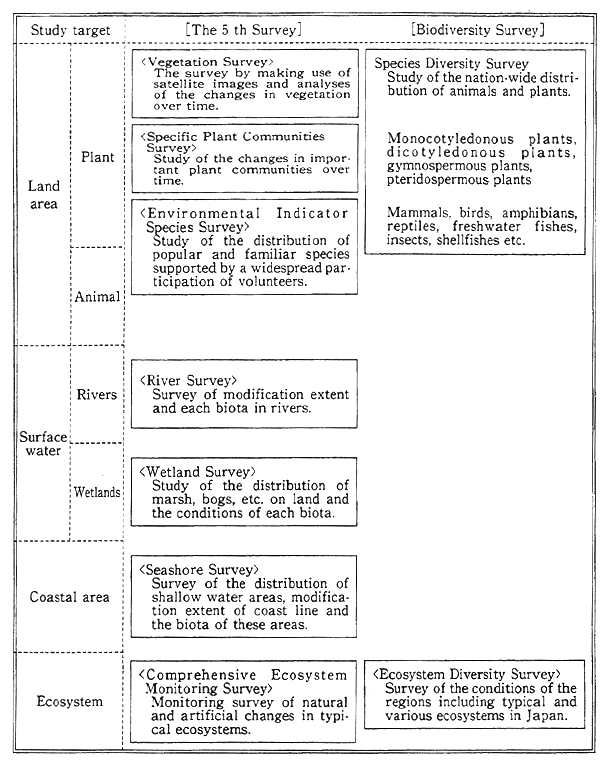
(1) Implementing various activities that promote familiarity with nature
To enhance the public's understanding and to develop an affinity and respect for nature visitor centers and nature study trails have been put to use. Learning about nature has been actively encouraged through the following:
1) On April 29, "Greenery Day", conducted Greenery Day Commun-ing with Nature Clubs at the Shinjuku Imperial Garden and national parks throughout Japan.
2) From July 21 through August 20, during the Communing with Nature Movement, conducted at natural parks throughout Japan nature observation meetings and related events. As the main event the 36th Natural Park Convention was held at the Hyounosen-Ushiroyama-Nagisan Quasi-national Park in Hyogo Prefecture.
3) With the goal of increasing an understanding of nature through nature walks October was named National Nature Trail Hiking Month. National Nature Trail Hiking Conventions were conducted in the 47 prefectures in Japan.
(2) Training guides to promote contact with nature
To develop the volunteers involved in activities such as those listed above and to support such activities, Park Volunteer Support Activities have been conducted at 11 places, including Akan Lakeshore Area in Akan National Park and Nature Interpretation Guide Training have been held.
To preserve the fauna and flora of natural parks, increase aware-ness of natural beauty and prevent damage to the parks from improper usage, supervisors at natural parks are being trained to provide guid-ance to park visitors.
3. Protection of Nature Through Public Participation
Following the example of National Trust in the United Kingdom, voluntary participation by the public in activities, such as fund raising for the acquisition and management of land with good natural environ-ment has progressed. Currently, national trust type preservation activ-ities, such as the Tenzinzaki Preservation Citizen's Movement in Wakayama Prefecture, are under way throughout Japan.
These types of activities to protect the environment are impor-tant because they are grass-roots. It is hoped that such activities take hold and grow.
In fiscal year 1994 the 12th National Convention on National Trust held to promote national trust type activities, conducted symposia to inform the public of the purpose of a national trust movement.
Moreover, nonprofit foundations that purchase and manage land as part of efforts to preserve the natural environment have been ap-proved as special nonprofit promotion foundations. Donations to such foundations receive favorable tax treatment.
Section2. Conservation of Natural Parks
1. Designation of Nature Conservation Areas
To preserve the natural environment, based on provisions in the Nature Conservation Law, the national government designates wilder-ness areas (areas maintained in their virgin state without the effects of human intervention) and nature conservation areas (areas, besides the wilderness areas, that from a societal standpoint are especially impor-tant to conserve).
As of the end of fiscal year 1994, five wilderness areas and ten nature conservation areas had been designated.
Further, in accordance with regulations, prefectural government may designate surrounding areas, judged from a societal perspective to be important to preserve, as prefectural nature conservation areas. As of the end of March 1995, there were 515 areas that had received such designation (Table 12-2-1).
Table 12-2-1 Wilderness Areas and Nature Conservation Areas

Note Data according to the Environment Agency.
2. Environment Protection in Nature Conservation Areas
Considering the importance of the wilderness areas and the nature conservation areas designated in accordance with the Nature Conservation Law, a study was conducted for the purpose of appropri-ate conservation. This study sought, by fiscal year 1989, to understand the conditions of all wilderness areas and nature conservation areas.
In fiscal year 1994 a follow-up study was started at the Onnebe-tsudak area for the conservation of wilderness area and in 1993 a study was conducted of the Shirakami Sanchi nature conservation area, an area that had been designated in the previous year.
3. Designation of Natural Parks and Review of Park Plans
(1) Designation of national and quasi-national parks
There are three different types of natural parks; 1) those areas with excellent scenery worthy of representing Japan are designated as national parks ; 2) those areas with scenery that fall short of the standards of a national park are designated as quasi-national parks; and 3) those areas with scenery that satisfies the standards of prefec-tural ordinances are designated as prefectural natural parks. Currently, there are a large number of designated natural parks which are contributing to the conservation of the natural environment and playing an important role in the experience and observation of nature, outdoor recreation and other contacts with nature.
As of the end of March 1995, in Japan there were 28 national parks (2,050,000 ha), 55 quasi-national parks (1,330,000 ha) and 301 prefectural natural parks (1,940,000 ha). The total land area covered by natural parks is 5,320,000 ha or 14.1 percent of Japan's total land area (Figure 12-2-1 and Table 12-2-2).
(2) Designation of marine park zones
To maintain marine scenery, the Director-General of the Environ-ment Agency can designate, in the waters of national parks and quasi-national parks, marine park zones, implement the necessary regulations and plan the appropriate usage of these areas.
In fiscal year 1994 Miyake Island in the Fuji-Hakone-Izu National Park was designated as Miyake Island Marine Park Zone.
As of the end of March 1995, 59 areas had been designated as marine parks, 29 areas in national parks and 30 areas in quasi-national parks. These marine park zones cover an area of 2,491 ha.
Fig. 12-2-1 National Park and Quasi-national Park in Japan
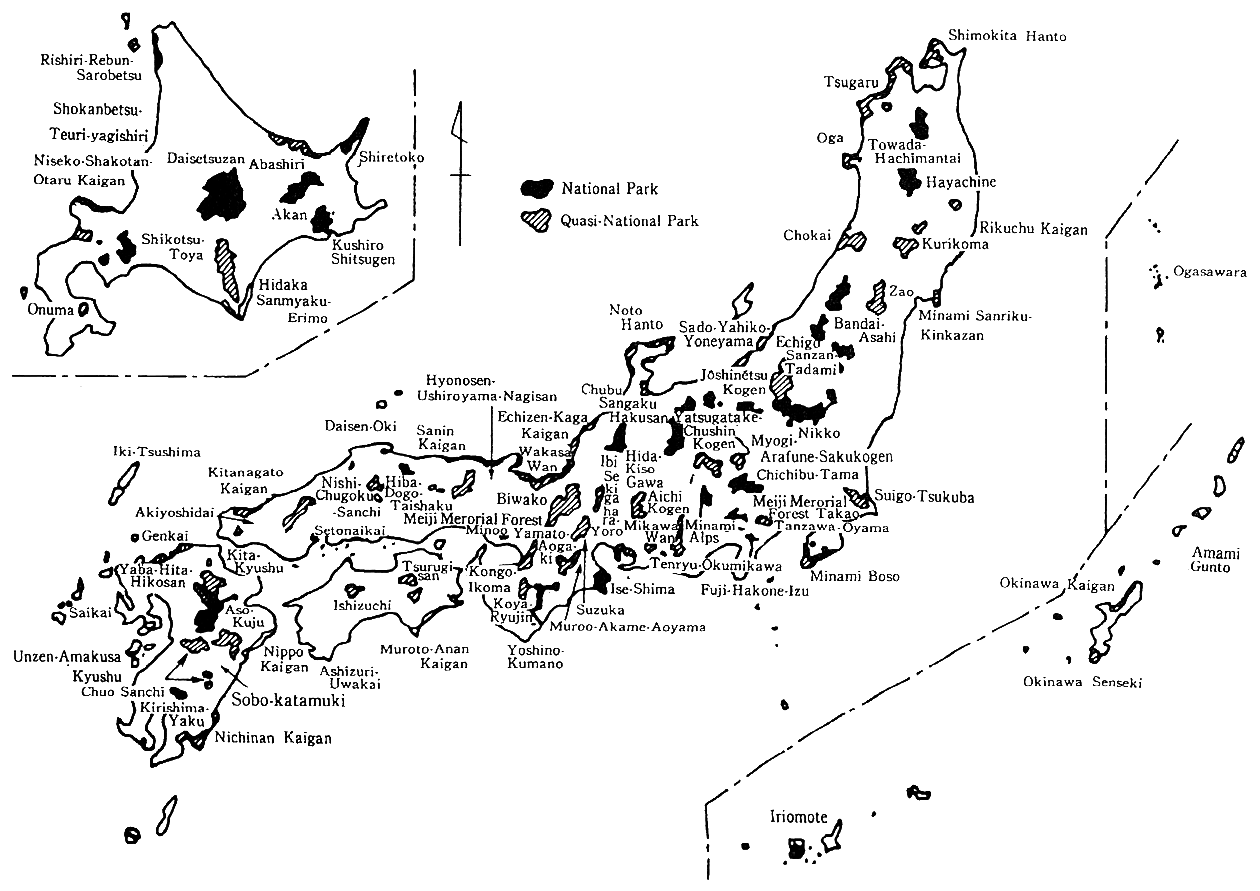
Table 12-2-2 Natural Park Area

Notes Data according to the Environment Agency.
* Total land area of Japan equals 37,781,209 ha (according to October 1993 data from the Geographical Survey Institute).
Table 12-2.3 Applications for Permission of Activities in National Parks (submitted to the Environment Agency)

Notes: 1. Data according to the Environment Agency.
2. "Others" includes such activities as changing the configurations of the land.
3. The figures in parentheses are applications for such activities in special protection zones.
4. The total number includes the number of deliberation by organization of the national government.
(3) Revision of park plans
To provide the appropriate levels of natural environmental pro-tection and park usage, natural park plans are established. However, to meet the changes in the society that surrounds the natural parks, the park plans have been revised about every five years, underlining the strengthening of nature conservation, since fiscal year 1973. In fiscal year 1994 the revised plans for the Rikuchu-kaigan National Park, the Setonaikai National Park (Seiban area) and the Shiretoko National Park were completed.
Further, the plans for quasi-national parks are revised, similar to national parks, by the national and prefectural governments. In fiscal year 1994 the revised plans for Kita-nagato Kaigan Quasi-national Park and the Niseko-Shakotan-Otarukaigan Quasi-national Park were com-pleted.
There are prefectural natural parks that do not have a park plan. Instructions have been given to make plans for these parks.
(4) Designation of vehicle regulated areas
In accordance with the 1990 revisions to the Natural Park Law, the Director-General of the Environment Agency can designate areas within special areas in national parks and quasi-national parks where the usage of motor vehicles, horse drawn carriages and power boats and the landing of airplanes is regulated.
To prevent damage to the growth and development of vegetation and wildlife due to vehicles which have become popular in recent years such as snowmobiles, off-road vehicles and motor boats, a total of 27 areas, 19 areas within national parks and 8 areas within quasi-national parks, were, as of the end of March 1995, designated as vehicle regulated areas. The total land area in these vehicle regulated areas is 136,289 ha.
4. Conservation of Nature in Natural Parks
(1) Protection of the scenic beauty in natural parks
1) Regulation of activities in natural parks
In order to protect the scenic beauty in natural parks, special zones, special protection zones and marine park zones are designated (Table 12-2-2). Permission from the Director-General of the Environ-ment Agency or the governor of the related prefecture is necessary to conduct certain activities in these zones. When giving permission, efforts are made to properly protect the scenic beauty of the area, such as with the application of the Guidelines to Assess on Various Develop-ment Activities in National Park Areas (excluding ordinary zones). Table 12-2-3 shows the number of applications submitted to the Director-General of the Environment Agency for permission to conduct certain activities in special zones and special protection zones in national parks.
Further, even in ordinary zones the governor of the related prefecture must be notified about certain activities. Guidelines, that strive to properly protect scenery, have been prepared concerning the construction of golf links in ordinary zones.
2) Research and studies on methods to manage the scenic beauty of natural parks
In order to control the management and protection of the most precious areas that are the central components of the scenic beauty, studies have been conducted on the elements that bring change to the characteristic ecosystems of the area. Efforts have been made to estab-lish methods to protect and manage these areas. In fiscal 1994 research and studies were conducted, such as a study on conservation measures for the Osanbe peak in the Daisen-Oki National Park.
(2) Environment conservation measures in natural parks
1) Beautification and cleanup projects
The trash brought by natural park visitors not only causes damage to spectacular views but also often creates environmental pollution such as the emission of foul odors. Therefore, efforts have been actively made to beautify and clean important areas in national parks that receive an especially large number of visitors. The growth of local beautifying and cleaning groups is encouraged and such groups are given assistance for their cleaning efforts.
The first Sunday in August has been designated as Natural Park Clean Day. With the cooperation of the related prefectures, beautifica-tion and cleanup activities are conducted simultaneously at all natural parks in Japan.
2) Projects to protect special vegetation
Precious vegetation exists in national parks and quasi-national parks. In order to conduct comprehensive measures for the protection and breeding of such precious vegetation, that must be protected along with its natural environment, assistance has been given to local govern-ments for expenses related to restoring areas, such as the Oze marsh-lands in Nikko National Park, to their original states.
3) Projects to exterminate the crown-of-thorns starfish, etc.
In order to protect coral reefs in marine park zones in national and quasi-national parks, that have extraordinarily large numbers of crown-of-thorns starfish and coral-eating gastropods, assistance has been given to local governments for crown-of-thorns and coral-eating gastropods extermination related expenses.
4) Measures for the appropriate use of motor vehicles
The increase in the number of motor vehicles entering areas in natural parks with spectacular nature has had bad effects on both the conservation and usage of natural park, such as causing damage to vegetation and obstructing the comfortable and safe usage of parks. Therefore, in accordance with the Outline on the Rationalization of the Utilization of Automobiles in National Parks by the Environment Agency in March 1974, traffic regulation plans based on the road traffic law and measures to substitute buses for personal cars have been devised.
5) Measures to preserve special natural environment areas
In order to protect precious ecosystems in national parks, protec-tion activities and periodic studies continue to be conducted, such as studies on measure to conserve the Odaigahara spruce forest in the Yoshino-Kumano National Park and the Sarobetsu wilderness area in the Rishiri-Rebun-Sarobetsu National Park.
Further, with the cooperation of the related local forestry offices, environment management projects have been implemented at the Shir-etoko National Park, Yaku Island area in the Kirishima-Yaku National Park and Hakuba area in the Chubu-Sangaku National Park.
6) Measures to preserve lakes and marshes
In order to preserve the water quality of lakes, marshes and rivers in natural parks, the construction of sewerage systems, such as specified public sewerage for environment conservation and other projects have been promoted.
(3) Strengthening of the management systems
National park and wildlife offices and their affiliates have been established at each national park to manage national parks with the cooperation of local governments and private organizations. In recent years there have been many changes in the circumstances surrounding national parks. Therefore, efforts have also been made to strengthen management systems that conforms to the special characteristics of each area.
1) National park and wildlife offices
National park and wildlife offices have been newly established in order to perform wide range of functions in national parks including protecting and managing the scenic beauty, providing instruction to business conducted inside park area, and guiding park visitors. The national park offices at eleven parks, including the Kushiro marsh, Nikko, were replaced by national park and wildlife offices. National park management stations have been established in each park area. At the end of fiscal 1994 there were 149 national park management officers (the so-called "national park rangers").
Further, in order to perform management in an appropriate manner in conformity with the situation in the area of each national park, management plans have been created. In fiscal 1994 management plans were prepared for eight areas in eight parks including the Shikotsu-Toya National Park.
2) Activities by private organizations
i. The National Park Beautification and Management Foundation performs a number of projects, such as natural park beautification and cleaning, park facility maintenance, and the dissemination of nature conservation ideas through 19 branches including Kamikochi area in the Chubu-Sangaku National Park, and Hachimantai area in the Towada Hachimantai National Park.
ii. The Honshu-Shikoku Bridge Fund for Nature Conservation provides assistance to beautification and cleaning, and the dissemina-tion of nature conservation ideas in order to conserve the natural environment of the area surrounding the Honshu-Shikoku Bridge (Kojima-Sakaide route) in the Setonaikal National Park.
iii. The Volunteer Fund for Nature Conservation provides assistance to 16 volunteer organizations that beautify and clean natural parks, protect wildlife and conduct research on wildlife, and give lectures about nature.
(4) Efforts to purchase private land in order to protect the natural environment
As part of a plan to reconcile landholders' rights, assistance is given to prefectures to purchase private land for the purpose of maintaining the scenic beauty in national and quasi-national parks, protecting wildlife in national wildlife protection areas and protecting rare native species of fauna and flora in protected areas.
The results of these efforts over the last five years are shown in Table 12-2-4. Up to now, 6,570 ha have been purchased in 63 areas at a total cost of 12,340 million yen.
Section3. Conservation of Forests
To conserve the forests, efforts are being undertaken based on the forestry planning system. The implementation of the forest land development control system, the protected forest system and measures against insects that are harmful to forests results in the maintenance and cultivation of forestry resources and allows the forest to demon-strate its many functions.
1. Forestry Plan
The forestry planning system was applied to demonstrate the multifunctions of the forests in a comprehensive manner and at a high level. These functions include the production of lumber, the prevention of disasters, the fostering of water resources and the preservation of the natural environment.
Table 12-2-4 Purchases of Privately-owned Land Through the Use of Proceeds from Local Government Bonds
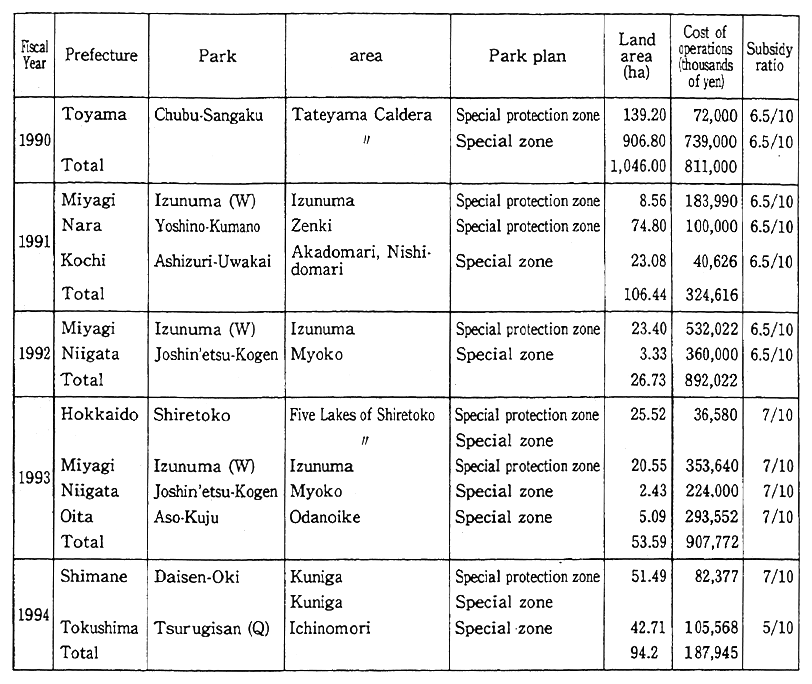
Notes:1. Data according to the Environment Agency.
2. In the column labeled "Park", a "Q" indicates a Quani-National Park and a "W" indicates a Wildlife Protection Area. All others are National Parks.
The forestry planning system includes the following among others; recognition of the special forestry related business plan which promotes multiple layered forests and the prolonging timber cutting period enabling a high degree of publicly beneficial forestry functions; implementation of the local forestry promotion plan which promotes forests development through thinning and nursery forest development; preparation of the related area forest plan which promotes measures to be taken urgently in special protected forest areas.
2. Forest Land Development Control System
To assure the proper use of forested land, the Forest Land Development Control System was created. The governors of prefectures issue and communicate approvals. Their offices are given guidance and assistance about inspection and supervision procedures.
3. Protected Forests
As of the end of March 1994 approximately 9 million ha of land was designated as protected forest. Based on the Protected Forest Organization Plan areas are designated as protected forests according to a schedule. Protected forests that have lost some of their fun-ctionality are designated as special protected forests. To achieve a high degree of forest functions, such as protecting the land, fostering water resources, preserving the natural environment and providing a place for rest and recuperation, this system strives to maintain and manage protected forests.
4. Management of Forest Conservation
To assure the multi-functionality of forests, assistance is given, based on the Woodland Disease Insect Extermination Law, to the extermination of insects that cause woodland diseases, especially for measures against the damage caused by pine weevils. Based on the Pine Weevil Countermeasures Law a variety of breeding prevention and extermination measures for pines in protected forests have, with consid-eration of environmental preservation, been conducted. These measures include tree felling (felling of diseased trees and the spreading of insecti-cides), special breeding prevention and extermination (aerial dispersion of insecticides), special tree felling (felling and crushing of diseased trees), supplementary tree felling (felling of trees that are physically damaged and the spreading of insecticides), and the introduction of the great spotted woodpecker, the pine weevil's natural predator. Further-more, broad-leaf trees have been actively planted in the areas surround-ing the pine forests that need to be preserved.
To manage forests properly, subsidies were provided for forest patrols at protected forests and forests that have high probabilities of fire, for the acquisition of machinery to prevent forest and field fires, and for the development of fire prevention forests and fire prevention woodland paths.
To encourage the public participation to forest management, the proceeds-sharing forest system and the establishment and organization of the Fund for Forests with Green and Water, a nationwide fund based on voluntary contributions by individuals and businesses, have been actively promoted. Comprehensive research on the maintenance and usage of forests, and efforts at knowledge dissemination have been performed.
National forests are classified by primary function in accordance with the National Forests Management Regulations. There are four classifications; national land for conservation; nature maintenance forests ; space usage forests; and lumber producing forests. Manage-merit and administration of each forest matches the forest's function. Forests held by the national government, where conservation of the natural environment is the most important function have been appropri-ately managed as nature maintenance forests.
Areas were designated as protected forests to preserve aborigine forests, thereby contributing to the maintenance of the natural environ-merit, wildlife protection, and the preservation of genetic resources, By the end of March 1995, 24 locations covering approximately 313,000 ha were designated as forest ecosystem protection areas.
In addition, needed research was conducted on the maintenance of the environments in areas inhabited by rare wildlife such as golden eagles and Tsushima wildcats. The projects, if necessary, according to results of the above-mentioned research, to maintain the environment in these and surrounding areas were performed.
Section4. Protection of Wildlife
1. Efforts to Protect Endangered Wildlife
(1) Enforcement of the Law for the Conservation of Endangered Species of Wild Fauna and Flora (LCES)
To systematically protect endangered species, various counter-measures were performed in accordance with the Law for the Conserva-tion of Endangered Species of Wild Fauna and Flora (referred to as "LCES" hereafter) enacted in 1993.
This law was partially revised in June 1994 to include as mate-rials with restricted conveyance "parts and processed parts" of endan-gered species. This revision was made to conform to the CITES.
Domestic endangered species are designated as National Endan-gered Species by the LCES. Capture, transfer and import/export of these species is restricted. When necessary, areas inhabited by these species are designated as Natural Habitat Conservation Areas and various activities are restricted. Programs for the rehabilitation of natural habitats and maintenance of viable populations are to be active-ly promoted for the purpose of increasing the populations of these species and maintaining the habitat environments of these species. A schedule for these programs is to be prepared to properly and effective-ly perform the projects.
Opisthotropis kikuzatoi, Hynobius abei Sato, 1934, Acheilognathus longipinnis, Polemonium kiushianum Kitam. were designated as National Endangered Species of wild fauna and flora in February 1995, adding to the 44 species already designated. The three species, eagle owl, Iriomote firefly and Kumejima firefly, were newly recognized and in December 1994 were designated as the first Temporarily Designated Endangered Species. Capture and conveyance of these species are regulated over the next three years and a research on their distribution and habitats was started.
Following the results of amendments to annexes at the 9th meeting of the Conference of the Contracting Parties to CITES in November 1994, additions and deletions were made in February 1995 to the International Endangered Species.
The Tanakia tanago Natural Habitat Conservation Area in Handa (Otahara City, Tochigi Prefecture) and the Callianthemum hondoense Natural Habitat Conservation Area in Mt. Kitadake (Asiyasu Village, Yapaanashi Prefecture) were the first habitat protec-tion areas to be designated.
To properly enforce the LCES, the national park offices were closed in July 1994 and replaced by newly established national park and wildlife offices. The national park and wildlife offices will strengthen the local management system. People who were appointed as Endan-gered Species Conservation Promoters will help to spread knowledge about the conservation of endangered species.
(2) Promotion of efforts for the conservation of endangered species of wild fauna and flora
As measures for the conservation of endangered species of wild fauna and flora, the following studies and projects were conducted:
1) With the participation of experts and academics, monitored the conditions in the habitats of approximately 110 kinds of endangered species.
2) Conducted studies to understand the change of habitat conditions of national endangered species of wild fauna and flora such as White's ground thrush, White-backed woodpecker, Lidth's jay and Amami woodcock.
3) At the Japanese Crested Ibis Protection Center in Sado Island, the primary protection institute and center of knowledge about Japanese crested ibis, made continuous efforts to breed the Japanese crested ibis and made progress toward the organization of a system for the preser-vation of Japanese crested ibis' cells and genes. Based on consultation between Japan and China, research on the breeding and protection of the Japanese crested ibis was started.
4) Established the Iriomote Wildlife Center, a center involved in the research, study, protection and breeding of rare wild fauna and flora species inhabiting Iriomote Island, particularly Iriomote wildcat. Monitored the habitat conditions of Iriomote wildcat.
5) As part of efforts to transfer Tsushima wildcat back to its original habitat, started to capture the Tsushima wildcat and conduct research on its breeding. In addition, monitored the Tsushima wildcat's habitat.
6) Performed construction to maintain and improve the environ-ment in the existing breeding places of the Short-tailed albatross. Made efforts to attract the population to new suitable breeding places as well.
7) Monitored the feeding and habitat of Japanese crane in winter, According to a January 1995 study, 607 Japanese cranes were counted.
8) Fed Blakiston's fish owl and provided them with nests. Transfer-red young birds to new habitats by using breeding cages at the Kushiro Marsh Wild Fauna and Flora Protection Center established in 1994.
9) Removed foreign species effecting the native "Miyakotanago" (Tanakia tanago) Habitat Area. Examined measures to improve and stabilize the environment of the habitat.
10) Artificial of propagation of rare flora species in Bonin Islands and re-introducion of them to their original habitat.
2. Strengthening of Measures to Protect Wildlife
(1) Promotion of wildlife protection and establishment of wildlife protection areas
In accordance with the 7th wildlife protection plan, establishment of wildlife protection areas by local governments (Figure 12-4-1) and other wildlife protection work, such as the rescue of wounded birds and mammals, progressed.
Table 12-4-1 Wildlife Protection Areas
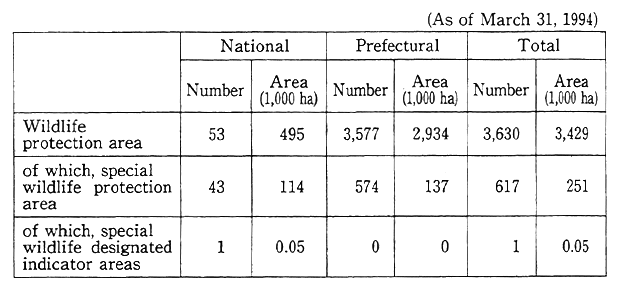
(2) Promotion of the protection of migratory birds
At the Katanokamoike pond in Ishikawa Prefecture which has been designated as a national wildlife protection area and a Ramsar site, the project of making water ways and planting were conducted in order to protect the habitat of waterbirds such as the white-fronted geese.
At Akkeshi Lake and Kuccharo Lake in Hokkaido, the Water-fowl and Wetland Center was established to protect water birds and wetlands and also to enhance knowledge and awareness about protec-tion of water birds and wetlands.
In November 1994, an international workshop on conservation of migratory water birds and their wetland habitats was held in Kushiro City, Hokkaido. This workshop was organized under the auspices of the Environment Agency and the Australian Nature Conservation Agency as a cooperative project in accordance with the Japan-Australia Migra-tory Bird Agreement. Ninety-two participants, from 17 countries along the flyway, concerned international organizations, and Japanese NGOs, joined the workshop. A statement was issued as a result of the work-shop, declaring the establishment of a network of protection areas along the flyway and the development of water birds conservation strategy.
In addition, banding research (i.e., tracking of "banded" birds) focusing on 60 bird observation stations in Japan (10 first class stations and 50 second class stations) was conducted in order to understand the ecology and routes of migratory birds. In addition, habitat research and fixed point research of the waterfowls have been performed to obtain basic data on the migratory conditions of wild geese, ducks, sandpipers and plovers.
(3) Damage prevention and wildlife protection measures
The Wildlife Management Manual Development Project was started in fiscal year 1992 in order to prepare guidelines for the coexis-tence of wildlife protection and human activities. In 1995 the subject of the project was wild boar. In addition, research on Japanese macaques and Asian black bear population management and the creation of techniques to prevent agriculture and forestry damage by these animals was conducted. Research on measures to prevent damage caused by large concentrations of migratory birds was also conducted.
Based on an agreement among the Environment Agency, the Agency for Cultural Affairs and the Forestry Agency, measure have been considered to prevent damages to the forestry industry by the Japanese serow. As a part of these measures, the population was controlled in Gifu, Nagano, Aichi and Yamagata Prefectures where damages were severe.
3. Promotion of Proper Hunting
(1) Current condition of hunting
In fiscal year 1994, the kinds of game birds and mammals were reviewed. Now, 29 kinds of birds including wild duck and pheasant and 18 kinds of mammals such as wild boar and deer are designated as game species.
The issuance of hunting licenses and the number of birds and mammals hunted are shown in Figure 12-4-2.
Table 12-4-2 Hunting Licenses Issued and Number of Wildlife Hunted
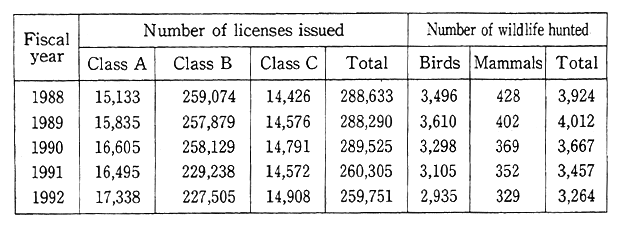
(2) Assuring proper hunting
Guidance was given to local governments and hunting organiza-tions before hunting season, in order to prevent accidents and illegal acts, and assure proper hunting.
(3) Establishment of hunting areas
A hunting area is a designated area for controlled hunting. The hunting area system regulates hunting by limiting the length of the hunting period and the number of hunters, while in the area, measures for protecting and breeding game birds and mammals are encouraged. The designation of hunting areas are shown in Figure 12-4-3.
Table 12-4-3 Designation of Hunting Areas
